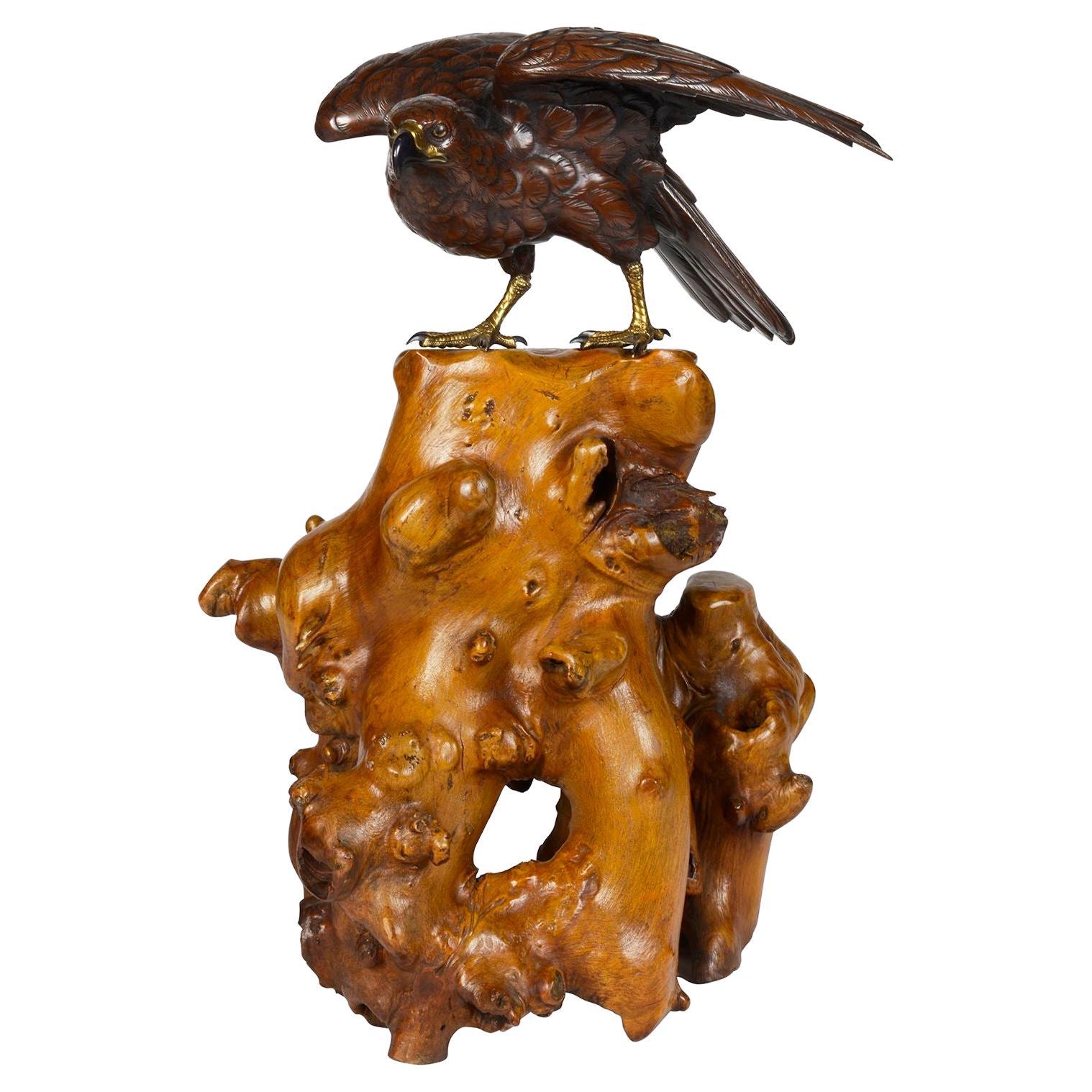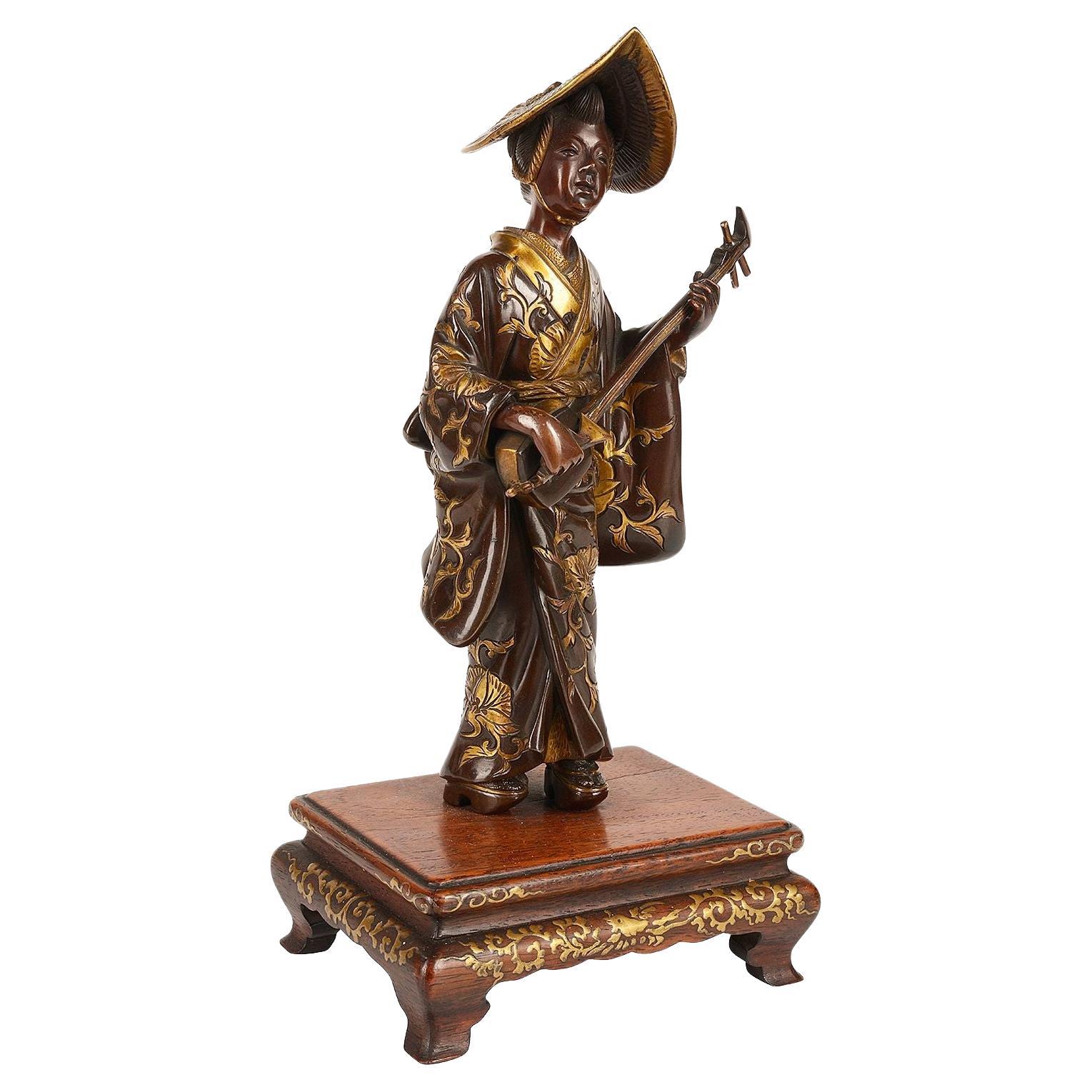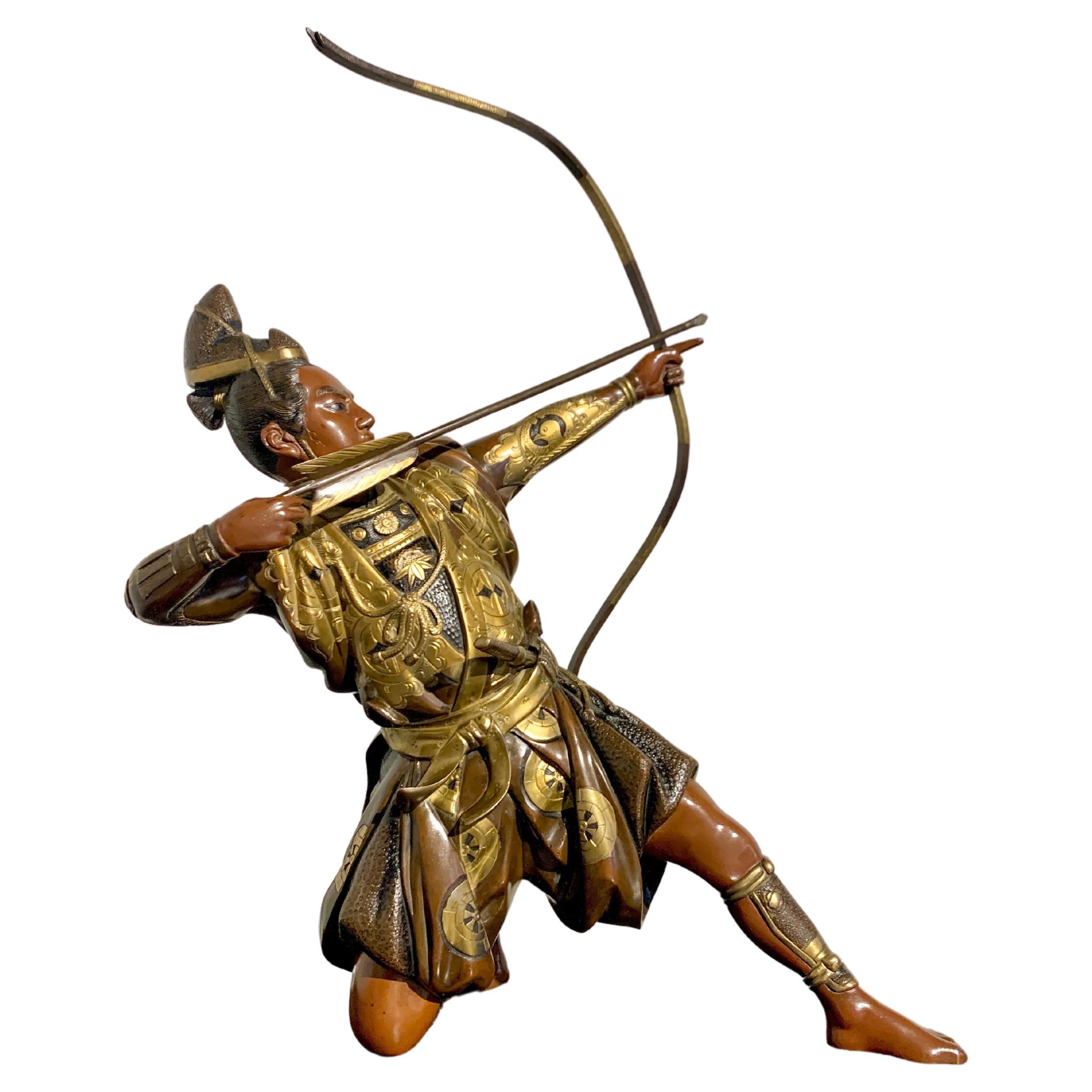Items Similar to Meiji Period High Quality Japanese Bronze Vase by Yoshida Zo
Want more images or videos?
Request additional images or videos from the seller
1 of 21
Meiji Period High Quality Japanese Bronze Vase by Yoshida Zo
About the Item
PRESENTING a GORGEOUS and EXTREMELY RARE Meiji Period High Quality Japanese Bronze Vase by Yoshida Zo.
Made in Kyoto, Japan circa 1885, by the famous bronze sculptor, Yoshida Zo.
It is a large (20 inches tall) bulbous shaped vase with elongated fluted neck. Made of tin/copper based bronze and brass base, with EXTREMELY HIGH QUALITY dragon and bird appliques.
In the style of archaistic Japanese bronzes but definitely late Meiji Period, as Yoshida Zo of Kyoto sculpted in the mid-late 19th Century.
Has the fully authentic impressed mark/seal of Yoshida Zo on the base.
The vase stands on a tiered circular platform base with chased floral decoration around the central portion.
Moving upwards, the vase has a large bulbous central section with a diameter of 10 inches. It has clouds and other chased decoration all over and 2 large recessed panels with applied bronze appliques of birds, branches, bamboo and cherry blossom flowers.
3 birds on each panel (total of 6) and we think they are ”Oriental Turtle Doves’.
The ‘detail’ to these birds and vegetation appliques is FANTASTIC!
The birds feathers, heads, tails etc are very detailed, as are the flowers and branches etc.
It is this attention to ‘detail’ that really makes this piece stand out as being of the HIGHEST QUALITY!
The vase extends upwards from the bulbous center, to a long-necked and fluted top section which widens to a scalloped open top, with a diameter of 5.3 inches.
The central and long-necked sections are separated with a bronze applique of a ‘coiled dragon’ holding a gourd. This dragon encircles the vase with extended claws.
The long-necked section, likewise, has a bronze applique of a ‘coiled dragon’, encircling the vase with extended claws. This section also has chased or engraved clouds all over.
Again, the QUALITY of the detail to the dragons is breathtaking! The heads, scales, legs, tails and large claws are of exceptional detail and quality.
CONDITION: Mostly in very good original condition. No losses to bird or dragon appliques. Central bulbous section has suffered a few ‘dings’ and ‘dents’ on one side only. 3 dents in total (see pics). Was always constructed in 2 pieces, with the long-necked top section attached to the bulbous base. Some very minor repairs at the point of attachment but not noticeable. The pricing reflects these issues and if it were ‘mint’ it would easily, be worth double the asking price.
Pieces of this quality and size, by Yoshida Zo, RARELY appear on the market. From our extensive research only 1 piece has appeared in the last 20 years at the major auction houses and it was at Sotheby’s in London in 2021, a Bronze Jardiniere, that had an Auction estimate of 2,000-3,000 GBP and sold for 2,142 GBP. Almost $3,000 (USD).
The stamp on the bottom of this beautiful vase is Yoshida zô’ (made by Yoshida (in) the western capital). Seikyo is an alternative name for Kyoto. The workshop of Yoshida in Kyoto was already active during the early Meiji period, producing bronze jardinières (suiban), vases, gongs and ornaments for both domestic and export markets. Yoshida’s Kyoto bronze ware workshop is well known for producing items of extremely high quality. His work was shown at the 1876 International Exhibition in Philadelphia.
Provenance: From a Private LA Collection
Condition: See full listing. Good.
Dimensions: Base diameter of 6.75 inches. Central section is 10 inches in diameter. Top opening has a diameter of 5.3 inches. 20 inches Tall. Weighs 14 lbs.
- Dimensions:Height: 20 in (50.8 cm)Width: 10 in (25.4 cm)Depth: 10 in (25.4 cm)
- Style:Archaistic (In the Style Of)
- Materials and Techniques:
- Place of Origin:
- Period:
- Date of Manufacture:1885
- Condition:Repaired: See full listing. Wear consistent with age and use. Minor losses. Minor structural damages. Minor fading.
- Seller Location:Dallas, TX
- Reference Number:1stDibs: LU3978138326932
About the Seller
4.9
Platinum Seller
These expertly vetted sellers are 1stDibs' most experienced sellers and are rated highest by our customers.
Established in 2015
1stDibs seller since 2018
349 sales on 1stDibs
Typical response time: <1 hour
- ShippingRetrieving quote...Ships From: Dallas, TX
- Return PolicyA return for this item may be initiated within 7 days of delivery.
More From This SellerView All
- Large Vintage Japanese Bronzed Sculpture of Toba on His MuleLocated in Dallas, TXPresenting a beautiful large vintage Japanese bronzed sculpture of Toba on his Mule. Some might say ‘Monumental’ .. being 34 inches tall ...Category
Mid-20th Century Japanese Japonisme Sculptures and Carvings
MaterialsBronze, Iron
- Bronze Dancing Shiva NatarajaLocated in Dallas, TXPresenting a GORGEOUS bronze dancing Shiva Nataraja. We are of the opinion that this is an early to mid 20th century piece. It has a zinc bronze finish...Category
20th Century Indian Anglo-Indian Sculptures and Carvings
MaterialsBronze
- Japanese Meiji Champleve and Bronze UrnLocated in Dallas, TXPresenting a gorgeous Japanese Meiji Champleve and bronze urn. Made in Japan during the Meiji Period circa 1880. The body of ...Category
Antique Late 19th Century Japanese Meiji Metalwork
MaterialsBronze, Enamel
- Japanese Meiji Period Sterling Silver 2 Handled Basket by Katsu MiyamotoBy Miyamoto Shoko 1Located in Dallas, TXPRESENTING a GORGEOUS, VERY HIGH QUALITY and EXTREMELY RARE piece of Japanese Meiji Period Sterling Silver 2 Handled Basket by Katsu Miyamoto. EXQUISITE, EXCEPTIONAL, RARE & IMPORTANT! This is definitely a Meiji Period piece due to the fact that it is marked with the sterling silver mark “jungin”. The Meiji period was from 1868 to 1912 and in 1928 a law was introduced in Japan compelling the use of decimal marks for silver. This pre-dates that decimalization law. We are of the opinion that it is from circa 1900. Miyamoto Shoko was founded in 1880 as the first silverware specialty shop. In 1899, Miyamoto Shoko’s silverwares were ordered by the family members of the Emperor of Japan, and to this day, they are making fine and graceful handicrafts with skillful craftsmen. Loved by numerous customers since the Meiji era, Miyamoto Shoko’s products have also been given to Princess Mako and Princess Kako of Akishino, as well as Princess Aiko Toshinomiya, on their birthdays. Katsu Miyamoto (宮本勝), in 1880, in order to increase the sales of tobacco and cigarettes to foreigners founded the Moyamoto Shoko company, which produced different silverwares in general and particularly silver cigarette cases. Miyamoto’s first name, Katsu (勝) in some sources is written as “Masaru”, since 勝 kanji can be pronounced in both ways. This basket is of the HIGHEST QUALITY imaginable! The top of the basket has the MOST GORGEOUS repousse work of flowers, probably lotus flowers, with leaves and foliage. It has an underlying chevron effect chasing, reflecting parquetry. The 2 handles are cast in the form of bamboo handles. The rim of the top likewise is cast as bamboo. The base is equally stunning in a different way! It is chased with a chevron effect, like parquetry flooring and the four feet simulate pieces of sliced bamboo with an interlinking gallery of support columns, likewise, simulating bamboo. The QUALITY of WORKMANSHIP is OUTSTANDING! The pieces weighs exactly 525 grams. This piece takes my breath away! This is one for the SERIOUS COLLECTOR of EXQUISITE AND RARE Japanese silver. You will not find another like it, for sale ANYWHERE ELSE IN THE WORLD …… I know as I have searched! Provenance: Acquired from a Dallas Private Collector. Dimensions: 9.6 inches wide, 7.6 inches deep and 2.75 inches tall ( 7.25 inches tall with handles up) Condition: Very good. It looks like the base 4 legged gallery, has been repaired/re-attached to the base, but otherwise it is excellent and of Museum quality. The Meiji period (明治時代 Meiji-jidai?), also known as the Meiji era, is a Japanese era which extended from October 23, 1868 through July 30, 1912.[1] This period represents the first half of the Empire of Japan during which Japanese society moved from being an isolated feudal society to its modern form. Fundamental changes affected its social structure, internal politics, economy, military, and foreign relations. The period corresponded with the reign of Emperor Meiji after 1868, and lasted until his death in 1912. It was succeeded by the Taishō period upon the accession of Emperor Taishō to the throne. Solid silver pieces...Category
Early 20th Century Japanese Meiji Metalwork
MaterialsSterling Silver
- 11C Ambika Buff Sandstone Western IndiaLocated in Dallas, TXPresenting a stunning piece of Indian antiquity from the 11th century, namely, a 11C Ambika Buff Sandstone Western India carving. From Western India. ...Category
Antique 15th Century and Earlier Indian Archaistic Sculptures and Carvings
MaterialsSandstone
- 10th Century Varaha Red Sandstone Central, IndiaLocated in Dallas, TXPresenting a stunning piece of Indian antiquity from the 10th century, namely, a Varaha red sandstone central India carving. From Central India. This piece has impeccable Provenance! It was purchased by a Private Dallas collector at Sotheby’s New York Auction on 24th September 2004. Sale Number 8008, Lot No. 28. Sotheby’s operate a twice yearly auction of Southeast Asian Art & Antiquities in New York in the months of March and September. The sculpture was described as: "Carved in relief with Vishnu in his boar incarnation stepping forward from the ocean, his left foot placed upon a lotus, two nagas beneath with their hands clasped in devotion. Vishnu’s primary right hand rests on his thigh in katihasta mudra while his remaining hands carry his attributes of mace, conch and discus. A diminutive figure of the earth Goddess, Bhudevi, whom Vishnu has rescued from the primeval waters, is balanced on his left elbow. The figure is bejeweled, wearing a broad, beaded waistband and necklaces and is placed within a niche between two pillars. Measure: Height 27 in. (68.6 cm.), circa 10th century. Provenance: Sotheby’s New York, March 21 & 22, 1990, Lot 253 Catalogue Note: This zoomorphic representation of Vishnu gained popular currency during the medieval period and was widely depicted in Central Indian Temple sculpture...Category
Antique 15th Century and Earlier Indian Archaistic Sculptures and Carvings
MaterialsSandstone
You May Also Like
- Japanese Meiji period bronze Hawk, circa 1890Located in Brighton, SussexA fine quality late 19th Century Meiji period Japanese patinated Bronze study of a Hawk, having gilded highlights such as the claw feet and face. Mounted on a carved hardwood root ba...Category
Antique Late 19th Century Japanese Sculptures and Carvings
MaterialsBronze
- Japanese Meiji period bronze Elephant fighting two Lions.Located in Brighton, SussexA fine quality Dramatic late 19th Century Japanese Meiji period (1868-1912) patinated bronze Elephant being attacked by two Lions, set on a carved wooden base, signed to the undersid...Category
Antique Late 19th Century Japanese Sculptures and Carvings
MaterialsBronze
- Japanese Meiji Period, Miyao Bronze Statue of a MusicianBy Eisuke Miyao 1Located in Brighton, SussexA fine quality Meiji period (1868-1912) Miyao bronze statue of a female muscian, having wonderful gilded high lights and mounted on a hardwood stand. Sign...Category
Antique 19th Century Japanese Sculptures and Carvings
MaterialsBronze
- Japanese Miyao Style Gilt Bronze Samurai Archer, Meiji Period, JapanBy Eisuke Miyao 1Located in Austin, TXA spectacular Japanese cast, carved, and parcel gilt bronze sculpture, okimono, of a kneeling samurai archer, signed Kiyotsugu (died 1894), Meiji ...Category
Antique Late 19th Century Japanese Meiji Sculptures and Carvings
MaterialsBronze
- Meiji period bronze plaque.Located in Brighton, SussexA fine quality late 19th Century (Meiji period 1868-1912) patinated and gilded bronze plaque depicting four men looking into the sky, two under a Palm tree, the other two standing next to a Tiger and holding a smoking vessel...Category
Antique Late 19th Century Japanese Sculptures and Carvings
MaterialsBronze
- Pair of Japanese Gilt Bronze Komainu by Ishikawa Komei, Meiji PeriodLocated in Austin, TXA striking pair of Japanese gilt bronze komainu by the renowned Japanese sculptor, Ishikawa Komei (1852-1913), Meiji period, Japan. The pair well cast, and robustly modeled. They ar...Category
Antique Late 19th Century Japanese Meiji Sculptures and Carvings
MaterialsBronze
Recently Viewed
View AllMore Ways To Browse
Resting Buddha Sculpture
Small Carved Buddha
Rabbit And Moon
Abhaya Asian Antiques
Buddha Relief
Samurai Sword Stand
Indonesian Bali Teak Wood Vintage Furniture
Antique Carved Japanese Warrior
Indonesian Stone Carving
Buddhist Prayer Box
Marble Elephant Midcentury Statues
Finely Carved Japanese Okimono
Jade Guanyin Statue
Myanmar Pottery
Wood Carving Elephant
Japanese Tanuki
Wood Carving Salmon
Bell And Dorje





